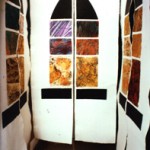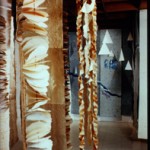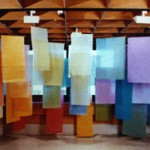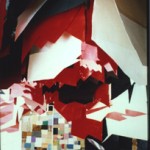25 January – 23 February 1997
VicHealth Access Gallery
National Gallery of Victoria
Read a review of the exhibition
About the exhibition
THE STORY BEHIND ‘ROOM FOR PAPER’
It all began in the long distant past of March, 1994 with an idea. After some dithering and lots of discussion, an application was put in for the use of the VicHealth Access Gallery at the National Gallery of Victoria. Our idea was fairly traditional, works on the walls, some 3D items and a long wall panel on the history of papermaking with examples of all the exciting things you can do with handmade paper. The application went in on May 16, 1995. A reply was received by July, 1995 with an expression of interest and an invitation to come and discuss the matter with Jane Scott, the curator. At this meeting the idea of an installation arose. A group of people, about ten, met on December 9, 1995 in the old Access Gallery and initiated the idea of a snake like wall of paper meandering through the gallery with areas or rooms clustered around the columns.
Our second submission was accepted. There was a second gathering of the group, this time in the new Access Gallery and we refined our ideas, now with the emphasis on rooms and emotions. A model was made and presented to the group at the AGM in July, 1996 along with requests for a variety of different papers that would be needed to complete the installation. To supply a slide for the 1996/97 gallery brochure, a group of about six people met in June 1996, and produced the first panels using available paper and some discs that had been assembled as an experiment. This assembly day gave me an indication of what we could achieve in one day and was the basis for my calculations for a timetable.
A1 paper production commenced in July and construction of the installation began on August 18. At these assembly days, lots of discussion occurred and ideas were changed and refined. There were 13 assembly days (‘Turbulent’ room, 4; ‘Maze’, 6; ‘Exotic’ area, 2; ‘Rainbow’ area, 1) with the last assembly day on January 12, 1997 Some of the discs were assembled on these days when there was time. The paper was assembled in the car port at 6 Comas Grove, Ashburton, exposed to a few of the elements and so on cold and windy days, we rugged up well and tried to protect the paper as best we could.
A grid, similar to that of the gallery was erected and Don made countless hooks by which to hang all the paper. Assembly days were always productive, with lots of discussion, laughter, food and sharing of ideas. Once completed, the panels were stored flat on the floor in the flat. It became the paper room as there was little room for anything else. Discs were also stored there, some strung up, others just in piles and as they grew in numbers, l knew this area of the exhibition would look great. Two crates were constructed in which to transport the paper, (also to store it at a later date) and cardboard boxes collected for the discs. The paper was transported to the gallery in ML’s ute and Helen’s trusty ‘Datty’. The most difficult and time consuming part was in transporting the paper from the loading bay at the rear of the gallery through the bowels of the building to the Access Gallery.
Meanwhile, Reba, as fund raiser, had ideas on a grand scale and organised an auction at Gavels Restaurant in the city. A donation by Box Hill TAFE paid for the invitations. The cost of food and wine was shared by POV and Gavels. Gavels also contributed the venue. Sixteen members contributed 36 pieces and raised $1718. This amount seemed ample at the time but as things progressed and our horizons broadened to include a video and a professional photographer, it was evident we would require more funds. Anne Marie Power and Gail pursued this and Anne Marie eventually persuaded her brother into a sponsorship of $1000. The invitations had been covered to some extent by a donation of $100 worth of paper by the Paper Place. There was also a donation of $200 from Gretchen Forrest.
Margaret Cromb was also quietly working on the publicity, initially in selecting the most suitable and appropriate places and then in contacting them. The result was a review by Robert Timms in the Herald Sun, February 5 1997, a profile and listing in the Art Almanac of December/January 1996/97 and February 1997, and also listings in the Sunday Age. Two radio interviews were conducted, both at 3AK, one with Robert Hicks of ‘Handy Works’ and the other with Michelle Adler of ‘Sunday in the Garden’. Gail offered to do a workshop for the Gallery Society members (at Box Hill Community Centre on February 15) and this gained us an article in the Society’s bulletin.
The exhibition committee consisted of Reba as fund raiser, Margaret as publicity officer and Gail with no specific tasks but who took on any jobs that came her way. Gail was particularly useful as a person to talk to and work out ideas and possible ways to proceed. And of course there was me, Marianne. We never met formally, communicating mainly by phone or at meetings, but each person was essential in their own way.
Hanging of the panels in the gallery commenced on Tuesday, 21 January and on the first day a lot was achieved with the installation taking shape. At this point, some members brought in their ‘dolls’ for inclusion in the ‘dolt room. The installation was completed on the Wednesday except for the patchwork wall which was finished on the Thursday, along with the lighting. Valda’s explanatory panels were also included. It was an excellent space to work in with its grid ceiling, white walls and the close proximity of the coffee shop. Also very cool given Melbourne was having some of its hottest days on record! All of the core people helped in the hanging supported by the ever reliable members. We always had plenty of support and because of this the hanging was very efficient and quick.
The opening on January 24 1997 was a great success with a greater than expected crowd and a really good feeling in the foyer of the gallery . Not being able to go up to the exhibition until after the opening speeches were completed created an expectant atmosphere. POV members provided an excellent array of refreshments of fruit, vegetables, cheese, dips and biscuits, all in keeping with the healthy message of the International Diabetes Institute. The champagne (at Gail’s suggestion) was a great hit. There was also orange juice. Opening speakers included Mr. Jim Cousins, Trustee of the NGV, Ms Noelle Wengier from the International Diabetes Institute , Helen, our esteemed president and Mr. Danny Power, our major sponsor. The response of members and the public was very gratifying.
The major activity associated with the exhibition was the big demonstration day, held on February 9,1997 in the Great Hall and the Lindsay Court. We did most of the setting up on the Saturday afternoon, with plastic being taped to the floor and the tables put in place. With over twenty demonstrators wanting to get into the gallery and set up, all within one hour, I am glad I was not there and that Helen took over the job of shepherding people. She must have done a good job because by the time I got there at 9-30am, all was in readiness and working efficiently.. We had members from the Bookbinders Guild, the Calligraphy Society of Victoria, the Conservation Department of the NGV as well as POV members. Activities demonstrated included; paper conservation, bookbinding, calligraphy, papermaking, pulp painting, marbling on paper, plant fibre paper, Japanese papermaking, momigami, paste papers, papier mache, A1 sheet formation, embroidery on paper, paper and basketry, paper cutouts, 3D paper work, printing on paper, paper collage, and casting with paper. It was a really wonderful day with a great atmosphere and lots of good questions and interested public. Even the weather was good after expectations and forecasts of rain. The clean up at the end of the day was amazingly efficient with most people out within half an hour.
Another associated event was the gallery talks, two in total, on February 6 and 13 in the Access Gallery by Gail and Marianne. A brief explanation of the installation and ideas behind the exhibition were given.
Finally February 24 and it was time to dismantle the exhibition. What took over two days to hang, months to make and years to organise, took just two hours to take down and pack. Again, there was a very efficient group of POV members to complete this job, transport it, and manoeuvre the crates and boxes up the Meat Market Craft Centre stairs to our little room where the panels and discs will be stored until they take on another life.
The installation has been recorded through a set of slides completed by Terence Bogue, a professional photographer, and through a video made by Danielle Evans and Lynn Davis. The slides were organised by Helen, and Gail has had a set of prints made from the slides for sale to members.
Review
ROOM FOR PAPER REVIEW
BY PETER DOUGHERTY
If there are two technological advances which can be credited with carrying our Civilisation to the point at which it now stands, cybernetics notwithstanding, they must surely be the wheel and paper. The wheel can take the credit for the birth and spread of hard core technology which most observers would concede is a two edged sword. Paper however can be viewed in an entirely different light. Without it, universal literacy and education would not have been conceivable, let alone achievable. Without paper, packaging would never have developed and the domestic buying and selling of goods would still be carried out in the manner of primitive tribal societies. The universal availability of paper has had a widespread and all encompassing impact on the life of man, yet its importance is easily overlooked in a world of whiz-bang gadgetry.
It was with some of these thoughts in mind that I visited the VicHealth Gallery at the National Gallery of Victoria to see ‘Room for Paper’, an installation created and presented by members of Papermakers of Victoria Inc.
‘Room for Paper’ turned out to be a very sophisticated installation which set itself three agendas. It set out to educate its public to the omnipresence and importance of paper in our lives, it explained something of the history and technology of paper and it created a world of paper through which the viewer could wander and experience the immense variety and expressive qualities of handmade paper.
Papyrus, we discover is a river-side sedge type plant which was used to make the earliest known form of paper. The pith from its soft, triangular stem was split into ribbons and used, as a writing material by the Egyptians, Greeks and Arabs over 3,000 years ago. Eventually it was formed into rectangular pages and bound to make books. Much ancient literature is still preserved on papyrus. Paper as we now know it was probably brought by Arab traders to the West from China where it was known in early Christian times. The materials first used for its manufacture were bark, linen rags and later, esparto grass from North Africa and Spain. The method of manufacturing paper by felting fibres derived from various plants used 2,000 years ago has changed very little to this day
After walking under a bank of paper clouds one enters the gallery to be met with an amazing array of colours and shapes, but it is apparent from that first moment, that you have wandered into something far more exciting than a three dimensional exhibition. It is a series of mini environments and like the laneways of a strange village they all demand to be explored. What one finds on this exploration is folded, moulded, collated, shredded, plaited and embossed handmade paper, each piece telling part of the story.
Different areas of the installation are designed to evoke particular emotional responses or Conjure up a memory. Having entered the space, you encounter the ÎRainbow/Transcendent Areaâ which consists of series of diaphanous sheets of coloured, handmade paper suspended in space and representing the spectrum of the rainbow. Moving on one comes to the ‘Tranquil Area’ in which hundreds of different sized paper discs are threaded together and hang from the ceiling. Their colours are muted and their warped forms create positive and negative space within the units as well as between them. The use of enclosed and surrounding space plays an important role in all the component parts of this installation and underlies its function as sculpture.
To the left before returning down the other side of the gallery stands the ‘Turbulent Room’. Possibly because of its strident red, black and white colour scheme and its harsh jagged shapes it is more enclosed than the other areas. Perhaps there is a feeling that its excessive energy needs to be contained.
The areas down this side of the gallery are smaller and more intimate. They need to be observed from outside or to be peered into. Instead of being embraced by the works one is now an observer perhaps even a voyeur. Here is ‘Shrine’, consisting of found paper images displayed on a suspended veil and ‘Cathedral’ which uses marbled paper shaped to imitate gothic windows or icons. ‘Spring’, ‘Summer’ and ‘Autumn’ are all represented by different colour and form configurations. ‘Spring’ has the vibrant shapes and colours of new life, while ‘Summer’ uses the stronger colours and still forms of high summer. ‘Autumn’ is demure. The last of the enclosed areas is the ‘Doll Room’ into which one peers through torn paper to see an installation of moulded mask forms. To leave, one walks between the ‘Sails’, a maritime installation or the abstracted bird forms of ‘Johnathon Livingston Seagull’ on the opposite wall. Sitting between them is ‘Exotic’, a work evoking the forms of tribal art with its plaits and cave painting motifs. Perhaps this is a mid-ocean island, perhaps an acknowledgment of the societies which didn’t use paper.
Tying everything together is a ‘Patchwork Wall’, which is actually the rear wall of the gallery. In its own right it is a large Paul Klee type mural, but viewed across the gallery it also serves to colour in all the negative spaces surrounding the other components of the installation. It recalls children’s school books in which all the left over spaces have been coloured in.
Working with 12 artists could be a curator’s nightmare, but this installation ‘Room for Paper’ has worked well because it is a collaborative effort, and as the works are not attributed it can only be read as such. Twelve members of ‘Papermakers of Victoria’ have put this installation together with many others contributing paper and ideas. That they have produced a little world of magic and not a curator’s nightmare is a tribute not only to their artistic skills but also to their collaborative abilities.
Peter Dougherty.




